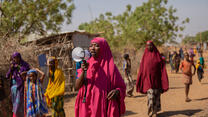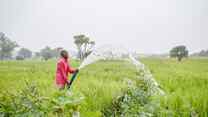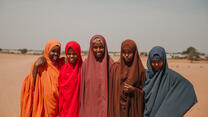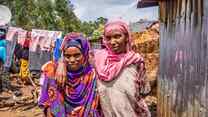IDA Funding for Refugees and Hosts: 5 Ways to Improve and Why We Need More
The International Rescue Committee (IRC) and the Center for Global Development (CGD) have been closely following the rollout of the World Bank IDA18 sub-window for refugee hosting nations, particularly in East Africa (Ethiopia, Uganda), West Africa (Cameroon, Chad), and Asia (Bangladesh). In our new policy note, we outline recommendations for the implementation of the IDA18 sub-window moving forward and makes the case for a sub-window in the IDA19 replenishment. Below, you’ll find a summary of those recommendations.
For too long, the international community has accepted the convenient fiction that refugee crises are temporary. The reality is far from this. On average, a refugee is displaced for 10 years, and after being displaced for five years, the average jumps to more than 20 years. The world could no longer ignore this reality in 2015, when more than one million asylum seekers and migrants arrived to Europe seeking refuge and opportunity. The phenomenon, however, was nothing new for the numerous refugee-hosting countries around the world. These countries, many of which are in the developing world, are all too familiar with the limits of traditional humanitarian approaches—short-term, siloed, and focused on life-saving needs.
In 2016, the World Bank recognized the need and tremendous potential of development responses to refugee crises. It launched the Global Concessional Financing Facility to offer highly concessional financing to middle-income countries hosting refugees. The Bank also made the decision to dedicate $2 billion in its IDA18 replenishment (July 1, 2017–June 30, 2020) for additional concessional financing to low-income countries hosting significant refugee populations. With these commitments, the World Bank has emerged as a game-changing force in responding to protracted displacement. The promise of multiyear financing, expertise in poverty reduction and strengthening services, and strong relationships with host governments—combined with a meaningful policy dialogue on refugee rights and responsibilities—offers the potential of real improvements in the lives of refugees and their hosts.
As IDA Deputies come together for the IDA18 midterm review in Zambia, IRC and CGD offer reflections on the progress and challenges associated with the refugee sub-window, recommendations on how to correct course where needed, and thoughts on whether and on what terms the refugee and host sub-window should be renewed in IDA19.
Five areas of success and challenge in the IDA18 refugee and host communities sub-window
Based on our observations and assessments of the IDA18 refugee and host communities sub-window over the past year and a half, World Bank and IDA Deputies should focus on these five issues:
1. Refugee-related policies
Amid a global retreat of leadership on refugee issues, the World Bank has made considerable strides in working with host governments to improve refugee policies. Self-reliance—and toward that, access to livelihoods, education, and greater freedom of movement—is one of the most politically sensitive issues. Despite this, the Bank has supported considerable policy progress in places like Ethiopia. However, there are also places such as Cameroon where the Bank has fallen short of commitments to improve policy, favoring disbursement of funds over tough conversations with governments. In its country operations, the financing sub-window arguably needs a clearer focus on achieving policy changes that can improve the lives and self-reliance of refugees to have sustained impact.
2. Accountability for outcomes
The Bank has outlined clear objectives for the sub-window, such as to promote refugee welfare and inclusion, support livelihoods in host community areas, and support legal solutions. However, the results framework fails to include goals, targets, or indicators that measure progress toward self-reliance among refugees and host communities. While not standard practice for Bank financing sub-windows, this should be prioritized given the unique objectives of this sub-window to meet the needs of refugees and host communities. Building on some promising steps in project indicators that capture outcomes disaggregated by nationals and refugees, the World Bank should define a set of outcomes up-front that feed into discussions around country-level policies and project priorities. These should be designed to align with the host country’s development priorities, and outcomes can serve as a benchmark for evaluating progress and success of programming for refugees and hosts.
3. NGO and civil society engagement
The Bank has established and grown a strong and commendable relationship with UNHCR. This partnership has been a significant driver of the World Bank’s success at bridging humanitarian and development approaches. That said, the Bank has fallen short of an inclusive and transparent consultation process with NGOs and civil society on the ground. Consultation and engagement with other stakeholders tends to be ad hoc. NGOs and civil society have their ears to the ground on refugee and host community needs, and can provide valuable input on what will work and what won’t when implemented. Over time, the Bank should develop protocols for deeper engagement with a range of actors, including NGOs, civil society, businesses, researchers, and others.
4. Development partners
The Bank has broken new ground in providing multi-year development support to meet the medium- and longer-term needs of refugee hosting countries. The Bank has created a roadmap of sorts in its work thus far with UNHCR, and donors and other development actors can easily draw on that mapping to identify areas of complementarity and opportunities for programming that works in tandem with Bank activities. To continue moving forward will require co-funding from other development donors—donor governments, regional bodies, and other multilateral banks. This will amplify Bank investments and help maximize impact.
5. Faster and more standardized practices
The World Bank has entered a humanitarian-dominated field and contributed its capacity and expertise in rigorous socioeconomic data collection, analysis, project design, and evaluation. In forging medium- and longer-term responses, these are critical. However, they must be coupled with the ability to implement at a relevant pace. The Bank needs to find a better balance between its requirements to deploy resources and the faster pace at which it must operate in refugee contexts. The Bank could design and enact more standardized protocols, including common assessment and planning tools and procedures to quickly deploy surge staff.
The sub-window should be renewed with IDA19
Since the IDA18 sub-window was created, new crises have generated large-scale displacement—from the influx of South Sudanese into Uganda, to the mass displacement of Rohingya refugees to Bangladesh. In increasing financing for host states, the World Bank can help meet needs directly as well as send a signal to other global institutions and donors that they, too, should prioritize support for, and policy dialogue with, refugee-hosting countries.
We recommend that there be a similar sub-window for refugees and hosts in the IDA19 replenishment, but with greater resources that reflect increased need. Such a window should consider the emerging lessons from implementation of the IDA18 sub-window, and identify improvements that can help ensure greater impact is achieved and adequately measured. Specifically, an IDA19 sub-window should:
1. Prioritize policy changes that will directly and indirectly enable self-reliance among refugees and host communities.
2. Define a set of outcomes, targets, and indicators, for refugees and host communities, for the sub-window that can guide results frameworks for projects financed through the sub-window.
3. Standardize how the Bank engages with local actors, particularly beyond UNHCR, to include NGOs, civil society, other UN agencies, and local governments.
4. Seek multiyear co-financing from other development actors to support and align with Bank projects that address the needs of refugees and host communities.
5. Balance the need for a speedy process and the length of time needed to develop projects that reflect the experiences of refugees and host communities.



